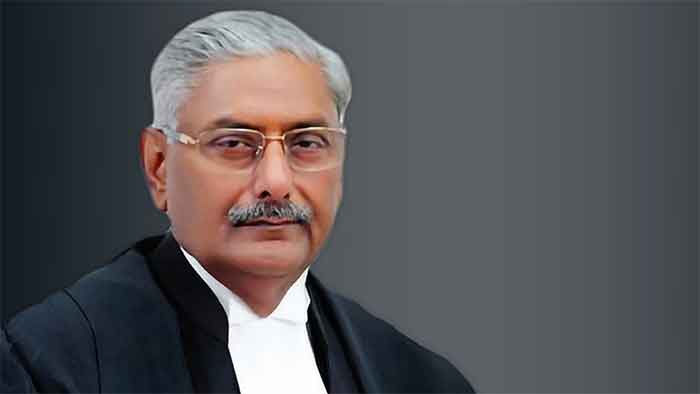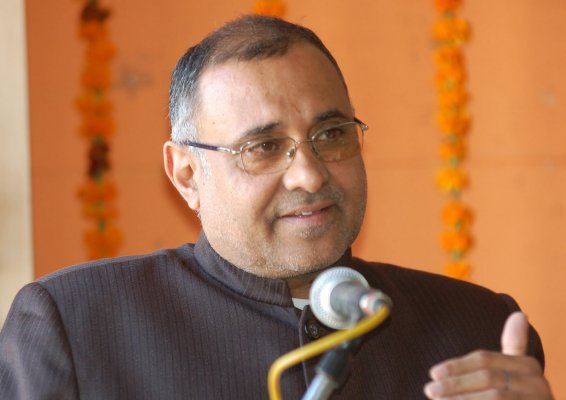
The former chairperson of the National Human Rights Commission (NHRC), Justice H. L. Dattu, during his tenure there (February 2016 – December 2020 ), described it as a `toothless tiger’, while giving vent to his frustration at his inability to deliver justice to victims of human rights violation. He blamed the built-in regulations that were imposed on the NHRC by the government, which he wanted to be done away with, in order to make the institution fully effective. His successor, Justice Arun Mishra now however seems to be moving in an opposite direction – accepting those same restrictive regulations without any reservation, and vociferously supporting the present government.
Justice Arun Mishra’s speech at the meeting to celebrate the foundation day of the NHRC on October 12, diminished the credibility of the NHRC, and undermined the trust of citizens in its power to deliver justice to victims of human rights violation. He has brought down the institution (or perhaps promote it, in his opinion !) from the status of the already humiliating role of a `toothless tiger’ to that of a grovelling poodle, being cuddled by the ruling party.
Justice Arun Mishra delivered his speech soon after the address delivered by Prime Minister Narendra Modi at the same meeting. Modi lashed out at “some people” for “interpreting human rights in their own ways, prioritizing their interests.” Although he did not identify these people, it was obvious that he had in mind critics, both domestic and international, who had been recently questioning him for the suppression of human rights of religious minorities, Dalits, journalists, political dissenters and social activists among others under his regime. Soon after Modi’s speech, the new chairperson of the NHRC, Justice Arun Mishra took over the stage. While addressing the meeting, he echoed Modi’s words almost verbatim, accusing `external forces of levelling false allegations of human rights violations against India,’ and stressed that these forces should be `opposed strongly.’ As if to reinforce his loyalty to the ruling party, he went a step further, by showering praise on – of all persons – the Union Home Minister Amit Shah for “ushering a new age” in Jammu and Kashmir and the North-east. (Re: Times of India. October 13). As every one knows from the daily media reports, the human rights of the common people of both these areas continue to be violated, due to the failure of Amit Shah’s ministry to provide them protection from the cross fire between his security forces and the secessionist insurgents. The NHRC chairperson’s praise for the Home Minister at this juncture is an insult to the victims of human rights violation by both the Indian state and the extra-state agencies.
But then, Justice Arun Mishra has been known for his self-confessed and widely publicized proximity to the BJP prime minister Narendra Modi. When he was a sitting judge in the Supreme Court in 2020, he heaped praise on Modi, describing him as an “internationally acclaimed visionary… versatile genius who thinks globally and acts locally” (Re: his speech at the inaugural session of the International Judicial Conference, January 20, 2020). Such an unabashed tribute to the ruling head of the state should have disqualified him from occupying the post of the chairpersonship of the NHRC. Its chairperson is expected to be an independent minded judge, and protect the human rights of citizens who are threatened by the government, irrespective of the political parties which may be running it. Did Justice Arun Mishra live up to these qualifications, when he was appointed by the present government as the NHRC chairperson ?
Apparently, he has not been able to separate his personal/political devotion to prime minister Modi on the one hand, and his responsibility to heed to the voices of the victims of the Modi government violation on the other. He is confirming the widely held suspicion that he is a political appointee by the present regime, which wants to get the NHRC headed by a chairman who will toe the line of the ruling party.
Historical background of NHRC
In order to understand the failure of the NHRC to protect human rights of Indian citizens over the last two decades, we need to examine the circumstances in which it was formed, and the constraints which were imposed upon it by the government.
The NHRC was set up on October 12, 1993 by the then Congress Prime Minister P. V. Narasimha Rao. Let us follow the sequence of events that preceded it. Rao at that time was facing opprobrium from both domestic and international human rights organizations for allowing the demolition of the Babri Masjid in December 1992, that led to a series of communal riots and killings in India all through 1993. Besides, his militarist response to civilian protests in Kashmir, and ham-handed dealing with public demonstrations by civil society groups against human rights abuses in Andhra, among other states, resulted in disastrous consequences.
As for Kashmir, the Narasimha government’s launching of the military `Operation Tiger’ there in August 1993, ostensibly to suppress secessionist terrorists, ended up in the harassment and killing of common citizens. In early October that year, a joint mission undertaken by the international human rights organization Asia Watch, and Physicians for Human Rights (PHR), visited Kashmir valley and documented cases of summary executions of dozens of innocent civilians and suspected militants who were taken into custody by Indian security forces and shot dead. These revelations put Rao in a bad light, both at home and abroad.
Before that, in January 1993, a researcher from the same Asia Watch, visited India, and investigated into cases of human rights abuses in Andhra Pradesh (where security forces, to bolster their claim of suppressing insurgency, were arresting and killing innocent villagers, branding them as Naxalites), and in the Narmada River Valley (where the police were harassing villagers who were protesting against their displacement by a dam that was being built by the government). Revealing these abuses, during its meetings with senior Indian officials, Asia Watch recommended that the Indian government should form a national human rights commission. (Re: `Human Rights Watch World Report, 1993 – India’).
Alerted by the wide-spread reports of abuses by Indian security forces, as circulated by the international media, the US put pressure on India. In May, 1993, the then US Deputy Assistant Secretary for South Asia, John Malott came out with a statement urging the Indian government to “take steps to bring the behaviour of its security forces into line with its constitutional commitment to human rights, especially in Kashmir…”
It was under these international pressures all through the months of 1993, that the Narasimha Rao government was compelled to set up the National Human Rights Commission in October that year. But even after its formation (to meet the demands of the UN Human Rights Commission), the government took care to turn NHRC into a straight-jacket institution under its helm.
Chairpersons of NHRC
It did this by appointing chairpersons whose credibility was doubted, giving rise to the suspicion that they might be in the good books of the ruling party. In fact, the issue of their appointment had been mired in controversies ever since the birth of NHRC. The first chairperson Justice Ranganath Misra was appointed on October 12, 1993 by the then Congress government. Indian human rights activists had reservations about him, because of his rather ambivalent role in the past as the head of the one-man Ranganath Commission, which was set up in April, 1985 by the Rajiv Gandhi government to inquire into allegations of organized violence that took place in Delhi following Indira Gandhi’s assassination. In his final report, although condemning the violence, Ranganath Misra resorted to a sort of diplomatic gobble.dy.gook. He understated the complicity of the Congress leaders and the police in the violence – thus appearing to give a clean chit to the ruling party.
The other controversial chairperson was Justice J. S. Verma, who was appointed on November 4, 1999. He was known for his infamous judgment delivered in 1995, from the Supreme Court, that bracketed Hinduism with Hindutva, by describing the latter as a `way of life.’ It was this that gave fillip to the BJP, which next year in its 1996 manifesto quoted the judgment to assert that the “Supreme Court, too finally, endorsed the true meaning and content of Hindutva…” Jutice Verma however made amends of sorts, when following the 2002 riots in Gujarat, he wrote a five page letter to the then Prime Minister Atal Behari Vajpeyee, indicting the Gujarat government. The current chairperson, Justice Arun Kumar Mishra’s obsequious tribute to the present ruling party leaders is thus in continuity of the NHRC’s tradition of being subservient.
A crippled NHRC
But besides appointing subservient chairpersons, the government from the very beginning saw to it that the NHRC remained a nominal showpiece to satisfy the international human rights groups. The means by which the government – irrespective of the political parties that control it – is empowered to restrict NHRC’s functioning, were well exposed by its former chairperson, Justice H.L. Dattu (who presided over the institution from 2016 till 2020). Although appointed under the BJP regime, he dared to step out from the traditional role of chairpersons of the past, by being outspoken for a change, about the problems that he faced in carrying out his duties. In an interview with a national newspaper in 2016 (when he was still heading the institution), he regretted that even at the end of painstaking investigations carried out by NHRC , he being hamstrung by the rules could only recommend remedial measures, or direct the state concerned to pay compensation. Recounting his experiences, he said: “We keep writing letters to the authorities concerned to implement our recommendations. But it is the sweet will of the authorities whether or not to implement NHRC recommendations.” He then appealed to the law makers: “It is for Parliament to decide whether to confer NHRC with some kind of contempt powers to make authorities to implement its recommendations.” He also reminded us that as of now, the NHRC “does not have the backing of the Protection of Human Rights to penalise authorities which do not implement its orders.” (Re: Times of India. June 2, 2016).
The BJP rulers, ever since their coming to power, have further crippled the NHRC by depriving it of its functionaries. In a submission to the Supreme Court in 2017, the NHRC complained about lack of adequate staff (caused by the government’s failure to appoint the required number). It stated that the number of allegations of human rights violation had gone up from 7,843 in 1995 to 1,14,167 in 2015. Custodial deaths (one of NHRC’s focus areas) shot up from 444 to 5,496 during the two decades. Yet, during the same period, the NHRC’s staff strength came down from 59 to 49 – due to non-filling up of vacancies by the government, which is the appointing authority.
Sumanta Banerjee is a political commentator and writer, is the author of In The Wake of Naxalbari’ (1980 and 2008); The Parlour and the Streets: Elite and Popular Culture in Nineteenth Century Calcutta (1989) and ‘Memoirs of Roads: Calcutta from Colonial Urbanization to Global Modernization.’ (2016).













































